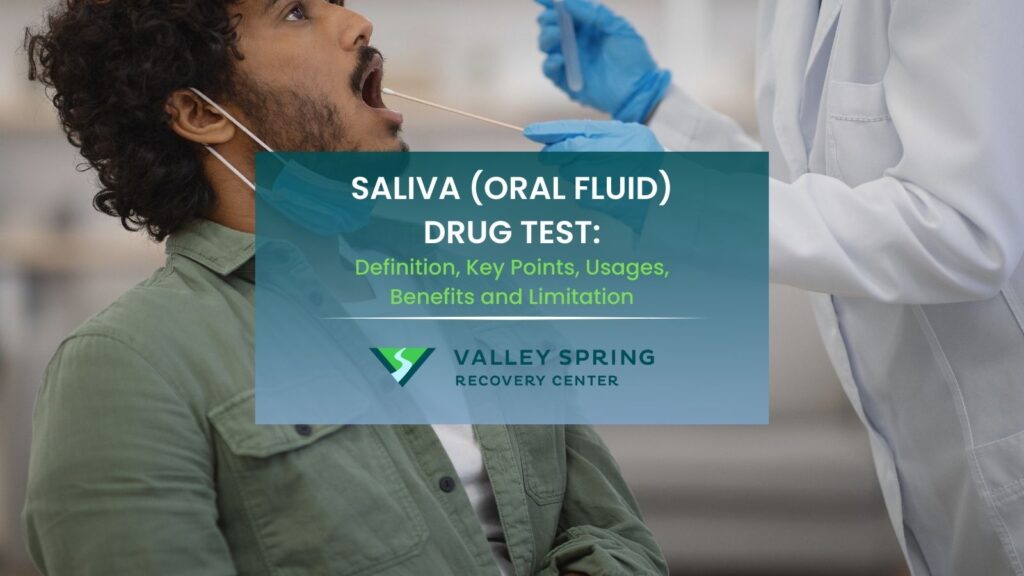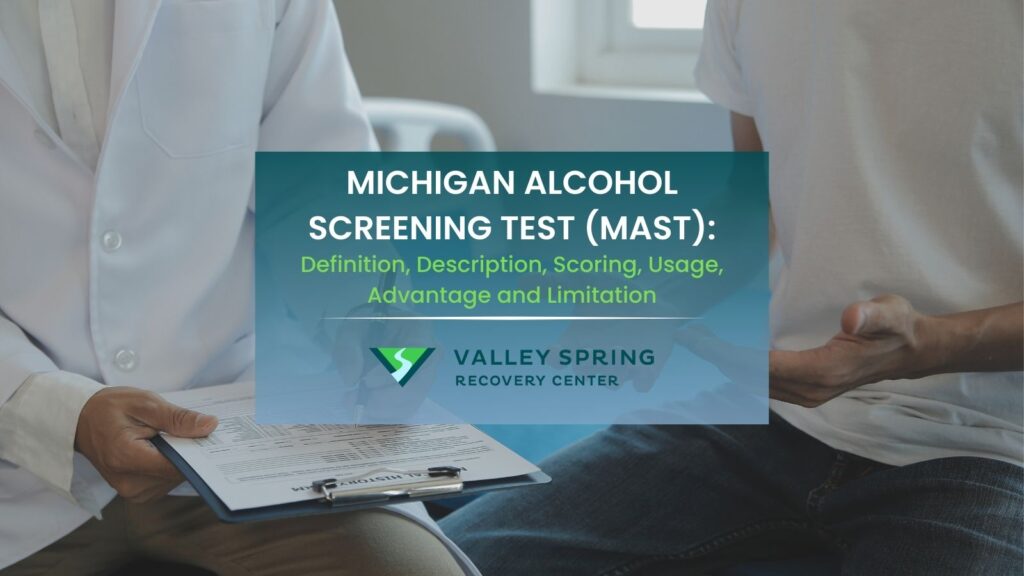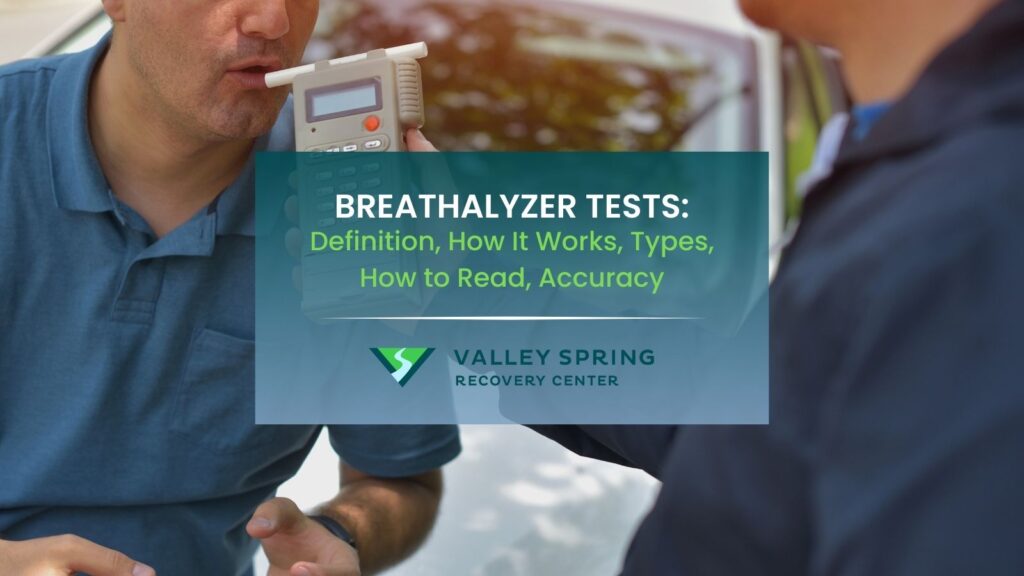The CAGE questionnaire, developed by Dr. John Ewing, an American physician and researcher, in the early 1970s, is a brief screening tool used to assess alcohol dependence and abuse. It consists of 4 simple questions aimed at identifying problematic drinking behaviors.
The CAGE questionnaire is scored by counting the number of “yes” responses to the four questions, with each “yes” scored as one point. A total score of two or more is often considered indicative of potential alcohol-related issues and warrants further assessment.
CAGE stands for:
C: Cut down
A: Annoyed
G: Guilty
E: Eye-opener
Because of how easy the CAGE questionnaire is to administer, it is particularly popular with primary caregivers according to JA Ewing “Detecting Alcoholism: The CAGE Questionaire” JAMA 252: 1905-1907, 1984.
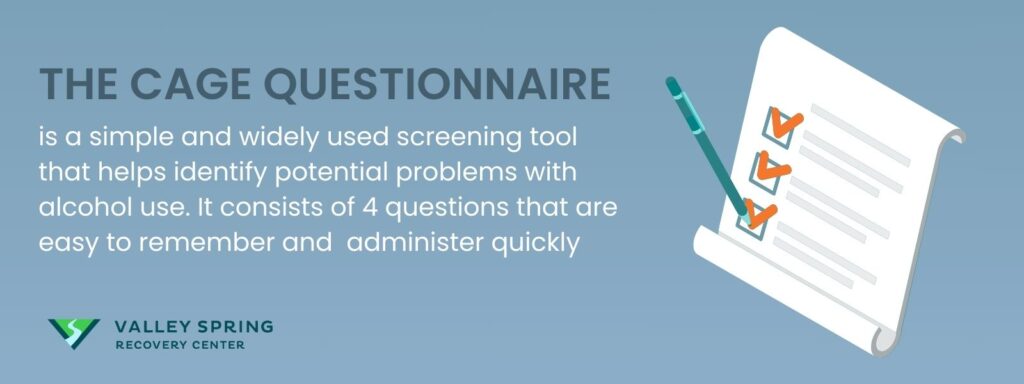
What is the CAGE Questionnaire?
The CAGE questionnaire is a simple and widely used screening tool that helps identify potential problems with alcohol use. Developed by Dr. John Ewing, founding Director of the Bowles Center for Alcohol Studies at the University of North Carolina at Chapel Hill, the CAGE questionnaire is an internationally recognized assessment instrument. It is particularly popular with primary care providers.
The CAGE questionnaire serves as a starting point for conversations about alcohol consumption and helps healthcare professionals identify individuals who may have alcohol-related issues by asking 4 questions to gain insights into the test takers’ relationship with alcohol. It’s important to note that the CAGE questionnaire is a screening tool and not a definitive diagnostic assessment for alcoholism or alcohol-related disorders. However, it provides a helpful starting point for healthcare professionals to initiate further discussions or assessments regarding alcohol use.
The CAGE questionnaire is highly effective. A study by Sheyesta Dhalla et al., titled “The CAGE Questionnaire for Alcohol Misuse: A Review of Reliability and Validity Studies,” reported sensitivity rates ranging from approximately 70% to 90%. This means the questionnaire can accurately identify a significant proportion of individuals with alcohol-related problems. The specificity rates for the CAGE questionnaire also range from approximately 70% to 90%, indicating that the questionnaire effectively minimizes false positives by correctly identifying individuals without alcohol-related problems.
The CAGE questionnaire is a valuable tool in the initial screening for potential alcohol-related problems, enabling healthcare professionals to take appropriate steps for further evaluation and intervention if necessary.
What Questions are included in the CAGE questionnaire?
There are 4 questions included in the cage questionnaire which are listed below.
- Have you ever felt the need to cut down on your drinking?
- This question asks if you have ever thought about reducing your alcohol intake or felt the need to control your drinking habits.
- Have people annoyed you by criticizing your drinking?
- This question explores whether friends, family, or others have expressed concerns or annoyance about your drinking behavior.
- Have you ever felt guilty about your drinking?
- This question examines whether you have ever experienced guilt or remorse related to your alcohol consumption.
- Have you ever had a drink first thing in the morning (eye-opener) to steady your nerves or get rid of a hangover?
- This question addresses whether you have ever resorted to drinking alcohol in the morning to alleviate withdrawal symptoms or start the day.
| Question | Response Options | Scoring |
|---|---|---|
| 1. Have you ever felt the need to Cut down on your drinking? | Yes / No | 1 point for “Yes” |
| 2. Have people Annoyed you by criticizing your drinking? | Yes / No | 1 point for “Yes” |
| 3. Have you ever felt Guilty about your drinking? | Yes / No | 1 point for “Yes” |
| 4. Have you ever had a drink first thing in the morning (Eye-opener) to steady your nerves or to get rid of a hangover? | Yes / No | 1 point for “Yes” |
| Total Score | 0 – 4 | Higher scores indicate greater likelihood of alcohol-related issues |
How are CAGE Questionnaires Scored and interpreted?
| Score | Interpretation | Recommended Action |
|---|---|---|
| 0 | Low probability of alcohol-related issues | No further action typically required |
| 1 – 2 | Moderate probability of alcohol-related issues | Consider further assessment or discussion, especially if other signs of alcohol-related problems are present |
| 3 – 4 | High probability of alcohol-related issues | Further evaluation, intervention, or referral to specialized services recommended |
What Happens If The CAGE Questionnaire Identifies A Substance Abuse Problem?
If the CAGE questionnaire indicates a potential addiction problem, the healthcare professional will take the following steps:
- Further Assessment: Additional tests and evaluations may be conducted to gain a more comprehensive understanding of your alcohol use and its impact on your health.
- Discussion and Counseling: You may have a discussion with a healthcare professional about your drinking habits, any concerns you have, and the next steps in addressing the issue.
- Treatment Options: If an addiction problem is identified, various treatment options may be recommended. These could include counseling, therapy, support groups, or, in some cases, medication.
- Referral to Specialists: You may be referred to addiction specialists or rehabilitation centers for more intensive treatment and support.
The CAGE questionnaire is a helpful initial tool, but it is often used alongside other assessments for a comprehensive evaluation of potential alcohol-related problems.
What are the Benefits of the CAGE Tool?
The CAGE tool offers 6 key benefits, including the following:
1. Simplicity and ease of use
The CAGE questionnaire consists of four simple and straightforward questions that are easy to understand and administer. It does not require specialized training to use, making it accessible to a wide range of healthcare professionals.
Charles P.O. (2008), in the paper titled The CAGE Questionnaire for Detection of Alcoholism, provides a commentary on the CAGE questionnaire, discussing its simplicity and effectiveness in detecting alcoholism. The paper also addresses the questionnaire’s role in clinical practice and its historical context.
2. Quick administration
The CAGE tool can be completed relatively quickly, typically within a few minutes. This makes it convenient for busy healthcare settings, such as primary care clinics, emergency departments, or routine medical visits.
3. Standardization
The CAGE questionnaire provides a standardized set of questions to assess alcohol-related issues. This standardization allows for consistent screening across different healthcare professionals, settings, and populations.
4. Sensitivity to potential problems
According to research by Nerys Williams, published on Occupational Medicine, Volume 64, Issue 6, 18 August 2014, Pages 473–474, the CAGE questionnaire has been extensively evaluated for use in identifying alcoholism and is considered a validated screening technique. It is reported to have a sensitivity of 93% and a specificity of 76% for identifying problem drinking, and a sensitivity of 91% and specificity of 77% for identifying alcoholism
5. Integration into routine care
The CAGE questionnaire can be easily incorporated into routine healthcare practices, such as general medical check-ups or primary care visits. Its simplicity and brevity make it feasible to administer during busy clinical encounters without significant disruption to the workflow.
6. Cost-effectiveness
The CAGE tool is a cost-effective screening tool for identifying potential alcohol-related issues. It does not require specialized equipment or extensive resources, making it accessible in a variety of healthcare settings.
Ultimately, the benefits of the CAGE tool lie in its ability to initiate conversations about alcohol use, raise awareness, and identify individuals who will benefit from further evaluation and support.
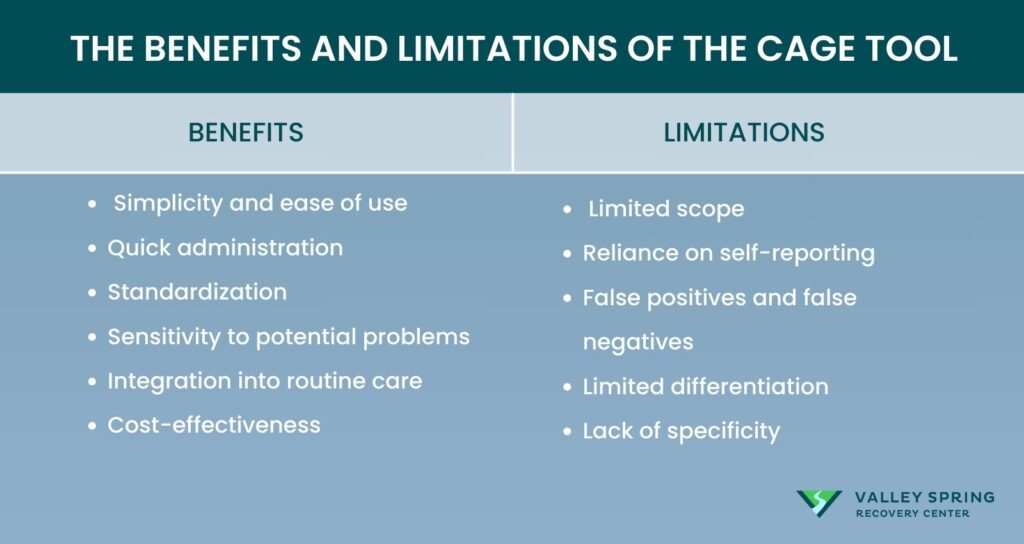
What are the Limitations of The CAGE Tool?
Here are the limitations associated with the CAGE questionnaire:
1. Limited scope
The CAGE tool primarily focuses on identifying potential alcohol-related issues. It doesn’t capture or address other substance use disorders or mental health conditions that may co-occur with alcohol problems. Therefore, it doesn’t provide a comprehensive assessment of an individual’s overall substance use or mental health status.
2. Reliance on self-reporting
The CAGE questionnaire relies on individuals’ self-reporting of their alcohol-related behaviors and experiences. This is subject to biases, such as underreporting or denial of alcohol-related issues due to social desirability or personal reluctance to disclose problematic drinking habits.
3. False positives and false negatives
The CAGE tool produces false positive results in some cases, meaning it identifies individuals as potentially having alcohol-related issues when they do not actually have a problem. Conversely, false negatives also occur, where individuals with alcohol-related issues are not accurately identified by the questionnaire.
4. Limited differentiation
The CAGE questionnaire does not differentiate between different types or severity levels of alcohol-related issues. It provides a broad indication of potential problems but does not provide detailed information about the specific nature or severity of the issues.
5. Lack of specificity
The CAGE tool is a screening tool and not a diagnostic tool. While it identifies individuals who require further evaluation, it does not provide a definitive diagnosis of alcoholism or alcohol-related disorders. A comprehensive assessment is necessary to establish a diagnosis and determine appropriate treatment options. It’s important to note that the CAGE questionnaire is designed for alcohol-related issues, while the modified CAGE-AID (CAGE Adapted to Include Drugs) screens for both alcohol and drug use.
What is the CAGE-AID Screening Tool?
The CAGE-AID screening tool is an expanded version of the original CAGE questionnaire that includes additional questions to assess both alcohol and drug use. The acronym “AID” stands for “Adapted to Include Drugs.” The CAGE-AID tool is designed to screen for both alcohol-related issues and drug-related issues in individuals.
Similar to the original CAGE questionnaire, each “yes” response is scored as one point, and the total score can range from 0 to 5. The higher the score, the higher the likelihood of alcohol or drug-related issues.
By including the additional question about drug use, the CAGE-AID tool provides a more comprehensive assessment of substance use, allowing healthcare professionals to identify individuals who may need further evaluation or intervention for both alcohol and drug addiction.
How Does The CAGE Questionnaire Compare with Other Alcohol Screening Tools?
The CAGE questionnaire is the shortest screening test when compared to other substance use disorder screening tools when compared to the AUDIT, MAST & TWEAK tests.
| Screening Tool | Number of Questions | Primary Use | Sensitivity | Specificity | Administration Time | Special Training Required |
|---|---|---|---|---|---|---|
| CAGE | 4 | Identifying potential alcohol-related issues | 91% (alcoholism) | 77% (alcoholism) | < 1 minute | No |
| AUDIT | 10 | Detecting hazardous and harmful alcohol use | 92% | 94% | 2-3 minutes | Yes |
| MAST | 24 | Diagnosing alcohol dependence | 98% | 93% | 10-15 minutes | No |
| TWEAK | 5 | Screening for risky drinking, especially in pregnant women | 79% | 83% | 1-2 minutes | No |
Are there any alternatives to the CAGE questionnaire for screening alcohol-related issues?
Yes, there are alternative screening tools for alcohol-related issues, such as the AUDIT (Alcohol Use Disorders Identification Test) and AUDIT-C (a shortened version of AUDIT). These tools offer a broader range of questions and can provide additional insights into an individual’s alcohol consumption patterns, related problems, and their severity levels.
Can the CAGE questionnaire be used as a standalone assessment or as part of a comprehensive evaluation?
The CAGE questionnaire can be used as an initial screening tool to identify potential alcohol-related issues, but it is typically recommended to be used as part of a comprehensive evaluation that includes additional assessments, clinical interviews, and diagnostic criteria to establish a formal diagnosis, determine severity levels, and guide appropriate treatment interventions.
What are the advantages of using the CAGE Questionnaire in primary care settings compared to other alcohol screening tools?
The CAGE Questionnaire has several advantages when used in primary care settings compared to other alcohol screening tools. Its primary strength lies in its simplicity and brevity, consisting of only four questions that can be quickly administered and easily remembered by healthcare providers. This makes it highly practical for busy primary care environments where time is limited. Additionally, the CAGE Questionnaire is effective in identifying individuals who may not openly disclose their drinking habits due to its focused questions on feelings and behaviors associated with alcohol use. Its straightforward scoring system allows for immediate interpretation and decision-making, making it an excellent initial screening tool. However, it should be noted that while the CAGE Questionnaire is efficient, it may not capture the full complexity of alcohol use disorders, which can be further evaluated with more detailed tools like the Michigan Alcohol Screening Test.
How frequently should the CAGE questionnaire be administered for ongoing monitoring of alcohol-related issues?
The frequency of administering the CAGE questionnaire for ongoing monitoring of alcohol-related issues may vary depending on individual circumstances, clinical judgment, and treatment goals, but it is commonly recommended to periodically reassess individuals at regular intervals (e.g., annually) or as needed based on changes in alcohol use patterns, treatment progress, or relapse risk.
How does the CAGE test relate to the ASSIST test?
The CAGE test is a brief screening tool specifically for alcohol use disorder, while the ASSIST test is a comprehensive screening tool that assesses alcohol, tobacco, and other substance use. While the CAGE test focuses solely on alcohol, the ASSIST provides a broader assessment of substance involvement across multiple categories, making it suitable for comprehensive screening in various populations and settings.
Dr. Michael Olla
All author postsShare This Post


